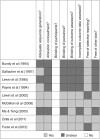Impact of self-management interventions on stable angina symptoms and health-related quality of life: a meta-analysis
- PMID: 24483947
- PMCID: PMC3945741
- DOI: 10.1186/1471-2261-14-14
Impact of self-management interventions on stable angina symptoms and health-related quality of life: a meta-analysis
Abstract
Background: Chronic stable angina (CSA) has a major negative impact on health-related quality of life (HRQL) including poor general health status, psychological distress, and inability to self-manage.
Methods: We used meta-analysis to assess the effectiveness of self-management interventions for improving stable angina symptoms, HRQL and psychological well-being. Nine trials, involving 1,282 participants in total, were included. We used standard inverse-variance random-effects meta-analysis to combine the trials. Heterogeneity between trials was evaluated using chi-square tests for the tau-squared statistic and quantified using the I2 statistic.
Results: There was significant improvement in the frequency of angina symptoms (Seattle Angina Questionnaire [SAQ], symptom diary) across trials, standardized mean difference (SMD): 0.30 (95% Confidence interval [CI] 0.14, 0.47), as well as reduction in the use of sublingual (SL) nitrates, SMD: -0.49 (95% CI -0.77, -0.20). Significant improvements for physical limitation (SAQ), SMD: 0.38 (95% CI 0.20, 0.55) and depression scores (Hospital Anxiety and Depression Scale), SMD: -1.38 (95% CI -2.46, -0.30) were also found. The impact of SM on anxiety was uncertain due to statistical heterogeneity across trials for this outcome, I2 = 98%. SM did not improve other HRQL dimensions including angina stability, disease perception, and treatment satisfaction.
Conclusions: SM interventions significantly improve angina frequency and physical limitation; they also decrease the use of SL nitrates and improve depression in some cases. Further work is needed to make definitive conclusions about the impact of SM on cardiac-specific anxiety.
Figures











Similar articles
-
Effectiveness of Psychoeducational Interventions for Improving Symptoms, Health-Related Quality of Life, and Psychological well Being in Patients with Stable Angina.Curr Cardiol Rev. 2008 Feb;4(1):1-11. doi: 10.2174/157340308783565393. Curr Cardiol Rev. 2008. PMID: 19924272 Free PMC article.
-
Randomized controlled trial of a psychoeducation program for the self-management of chronic cardiac pain.J Pain Symptom Manage. 2008 Aug;36(2):126-40. doi: 10.1016/j.jpainsymman.2007.09.015. Epub 2008 Apr 18. J Pain Symptom Manage. 2008. PMID: 18395397 Clinical Trial.
-
Persistent angina: highly prevalent and associated with long-term anxiety, depression, low physical functioning, and quality of life in stable angina pectoris.Clin Res Cardiol. 2013 Aug;102(8):571-81. doi: 10.1007/s00392-013-0568-z. Epub 2013 May 1. Clin Res Cardiol. 2013. PMID: 23636227
-
Telephone interventions for symptom management in adults with cancer.Cochrane Database Syst Rev. 2020 Jun 2;6(6):CD007568. doi: 10.1002/14651858.CD007568.pub2. Cochrane Database Syst Rev. 2020. PMID: 32483832 Free PMC article.
-
Effects of traditional Chinese exercise on physical and mental health and quality of survival in patients with stable angina pectoris: A meta-analysis.Curr Probl Cardiol. 2024 Dec;49(12):102872. doi: 10.1016/j.cpcardiol.2024.102872. Epub 2024 Oct 5. Curr Probl Cardiol. 2024. PMID: 39374678
Cited by
-
Cost-minimization analysis of three decision strategies for cardiac revascularization: results of the "suspected CAD" cohort of the european cardiovascular magnetic resonance registry.J Cardiovasc Magn Reson. 2016 Jan 11;18:3. doi: 10.1186/s12968-015-0222-1. J Cardiovasc Magn Reson. 2016. PMID: 26754743 Free PMC article.
-
Effect of the self-management education program on the quality of life in people with chronic heart failure: a randomized controlled trial.Electron Physician. 2018 Jul 25;10(7):7028-7037. doi: 10.19082/7028. eCollection 2018 Jul. Electron Physician. 2018. PMID: 30128093 Free PMC article.
-
Characterizing patient-oriented tools that could be packaged with guidelines to promote self-management and guideline adoption: a meta-review.Implement Sci. 2016 Apr 14;11:52. doi: 10.1186/s13012-016-0419-1. Implement Sci. 2016. PMID: 27079375 Free PMC article.
-
Relation of Angina Pectoris to Outcomes, Quality of Life, and Response to Exercise Training in Patients With Chronic Heart Failure (from HF-ACTION).Am J Cardiol. 2016 Oct 15;118(8):1211-1216. doi: 10.1016/j.amjcard.2016.07.040. Epub 2016 Jul 29. Am J Cardiol. 2016. PMID: 27561194 Free PMC article. Clinical Trial.
-
Efficacy and safety of oral Guanxinshutong capsules in patients with stable angina pectoris in China: a prospective, multicenter, double-blind, placebo-controlled, randomized clinical trial.BMC Complement Altern Med. 2019 Dec 11;19(1):363. doi: 10.1186/s12906-019-2778-z. BMC Complement Altern Med. 2019. PMID: 31829173 Free PMC article. Clinical Trial.
References
-
- Chow CM, Donovan L, Manuel D, Johassen H, Tu JV. In: CCORT Canadian Cardiovascular Atlas: A Collection of Original Research Papers Published in the Can J Cardiol. 2. Tu CJ, Ghali W, Brien S, editor. Toronto: Pulses Groups Inc. and the Institute for Clinical Evaluative Sciences; 2006. Regional variation in self reported heart disease prevalence in Canada; pp. 23–29.
-
- Murphy NF, Simpson CR, MacIntyre K, McAlister FA, Chalmers J, McMurray JJV. Prevalence, incidence, primary care burden, and medical treatment of angina in Scotland: age, sex and socioeconomic disparities: a population-based study. Heart. 2006;92:1047–1054. doi: 10.1136/hrt.2005.069419. - DOI - PMC - PubMed
Publication types
MeSH terms
Grants and funding
LinkOut - more resources
Full Text Sources
Other Literature Sources

